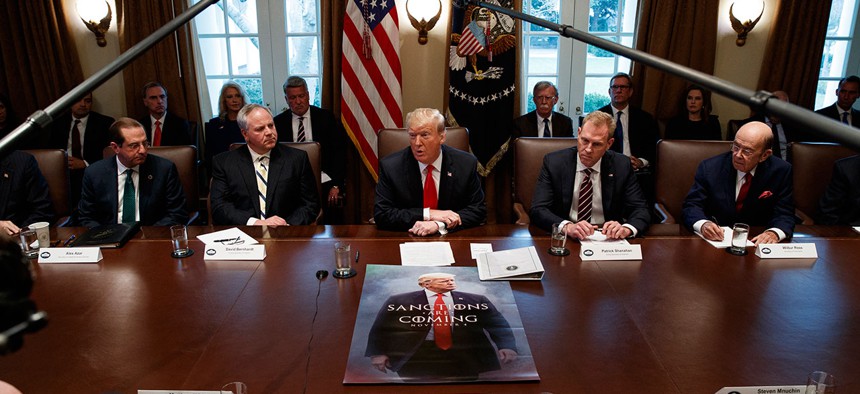Moreover, getting rid of the threat of a government shutdown might make the appropriations process worse, with Congress doing even less budgeting since the cost of failing to compromise would be lower. The Hill might leave the budget on autopilot for years at a time, never coming to an agreement on how to shape, update, and improve the services that Washington provides. A stuck-in-time budget would choke off the necessary, natural expansion of federal spending as the country gets bigger and inflation eats at the dollar.
Analysis: How to End Government Shutdowns, Forever
Congress should stop relying on one-off funding extensions to keep the government running.
As the third government shutdown of the Donald J. Trump presidency drags on, the miserable effects are piling up. Federal workers, hundreds of thousandsof whom are furloughed, are struggling to pay their bills and picking up temporary gigs to make ends meet; the Office of Personnel Management has encouraged them to bargain with their creditors and offer to do chores for their landlords. Contractors working in federal buildings are worse off, likely never to be made whole for their lost shifts. Taxpayers have lost access to everything from loans to museum tours, and businesses are complaining about the uncertainty emanating from Washington.
It doesn’t have to be this way. There are many paths to ending the shutdown—Trump could sign a funding bill without money for his border wall, say, or with paltry money for his border wall. Better yet, Congress could shut down the government shutdown option, forever.
It could do this by implementing something called an automatic continuing resolution provision, which legislators from both sides of the aisle have advanced numerous times over the past 30 years. Right now, when Congress cannot agree on how to spend money, it passes a continuing resolution, or CR, which continues federal agencies’ financing for a given period of time. Automatic CRs would absolve Congress from the responsibility of passing new CRs, preventing both the quick financing lapses and big, painful shutdowns.
The move would prevent the Senate from shutting down the government over disagreements with the House, Republicans from shutting down the government over disagreements with Democrats, and the White House from shutting down the government over disagreements with Congress. Money would just keep flowing at a steady rate, until Congress passed a formal budget or appropriations bill, and the president signed it.
For all that, the change would be marginal, not radical. Federal law already bars much of the government from closing up shop when financing lapses. And CRs are already common, necessary part of the budget process: Congress has usedthem more than 100 times in recent decades, with CRs keeping the government open for full years a few times. Several states have automatic CR-type provisions, and President Barack Obama signed a military-only automatic CR into law back in 2013.
The case for automatic CRs is straightforward: Shutting down the government is a painful, irresponsible, and stupid thing. Granted, the macroeconomic effects tend to be small, but they are not invisible and they are avoidable. Shutdowns have the potential to increase the jobless rate, bump up borrowing costs, and slow down growth. The worst pain is saved for the hundreds of thousands of federal workers and contractors affected, sometimes over and over again. Shutdowns mean lost wages mean evictions, higher interest payments, repossessed cars, and the like.
There is also the fact that voters tend to hate shutdowns, and want Congress to make deals to keep the government up and running. For good reason. Voters pay taxes that help finance a suite of services. Shutdowns deny voters those services. Right now, volunteers are desperately trying to keep the bathrooms clean at Joshua Tree and human waste is piling up in Yosemite; the Smithsonian museums and National Zoo have closed; it is impossible to get a marriage license in Washington; and entrepreneurs are waiting on their Small Business Administration loans. The longer the shutdown lingers, the worse the effects: late tax rebates, cancelled contracts, problems with public housing, and so on.
Granted, politicians do pass CRs in a timely fashion much of the time. And while voters don’t like shutdowns, they don’t tend to hate them enough to punish the politicians responsible for them at the polls. For that reason, and the leverage that shutdowns give politicians over one another and the motivation they give both sides to broker a deal, they tend to happen again and again.
There are also legal and procedural barriers to implementing automatic CRs. Reams of federal law prevents the government from spending money that has not been appropriated by Congress, after all. But decades of government memos and proposals from members of Congress suggest that such obstacles are not insurmountable.
All the counterarguments need to be weighed against the inanity of and pain caused by the current system. The annual budget process has broken down. The past few shutdowns have happened during a time of unified government. In this climate, it has become critical to improve Congress’s own processes, and to take away its ability to hurt the economy. One way to do that might be by ending government shutdowns once and for all.



